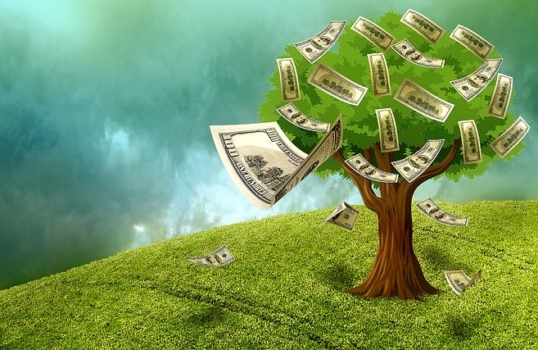Money, Debt, and Bitcoins
Suppose soaring inflation caused our money to be of so little value that it was no longer acceptable for business purposes. It should be obvious that a modern economy cannot function purely on barter trade. What would we do? This has happened in many countries. Usually, they turn to doing business in dollars. But suppose the dollar itself was seen to be too unreliable. In the ensuing chaos, all money would become unreliable. Imagine a world without money. Money did not always exist.
What the hell is “money”? It is one of the least understood things that we deal with every day. The pundits are always talking about how there is not enough money to do all the things Government wants to do. Of course, they also moan about out-of-control budget deficits at the same time as they insist there is a need for support payments to people and businesses hurt by the pandemic. Many bewail the Government sending out checks for money it does not have since it means they are just printing the stuff and that there will be a price to pay for such irresponsibility someday. Progressives are furious that all the money the Fed is splashing around is only serving to make the rich richer and widening the wealth gap between rich and poor.
What is money, and why is it so confusing? It is not a simple thing to explain or understand. Nevertheless, I am going to try.
If there were no such thing as money, all economic activity would have to be done via barter. “I’ll trade you so many chickens for your horse (or car or medical service or whatever).” That is clearly impossible when you are dealing with 747’s, tons of steel, and office buildings.
What is needed is some sort of “marker” (technically called a “unit of account”) that has an agreed value and can be used to fix the value of a chicken or a 747, etc. in terms of everything else. Anything can be used, but it needs to have a relatively stable value so that everyone can determine what their assets are worth at any time without wild fluctuations. This is why calls to make Bitcoins a new form of money are unlikely to go anywhere as long as its value goes up or down by 5% or so virtually every day. (I’ll come back to Bitcoins at the end.)
Governments assume the power to determine what is money and how much of it is in circulation. But that does not explain how its value is determined, how much is needed, or how it gets into individual hands when it comes off the Treasury’s printing presses.
Let’s do a thought experiment. Suppose there were just 3 countries. Country M strictly engages in manufacturing things. Country R makes almost nothing but has the natural resources that M needs to do its manufacturing. Country S is strictly a service country. It has few natural resources or manufacturing capability, but it can supply medical services, entertainment, and a host of other intangibles.
Obviously, in this situation, all three countries need the other two in order to carry on living. For trade to occur, they need to agree on what values to attach to the things they need to buy and sell. Let’s say they decide to denominate everything in dollars. (Something else could be used, but the same discussion follows.) Before they can do that, they have to agree on what a dollar is “worth”, or at least what will determine its value. At one time a dollar was officially declared to be worth a certain amount of gold, but then there was the question of how much gold was “worth”. That had problems because the quantity of gold in the world changed according to how much was discovered periodically. In 1857 a ship sank in a hurricane, taking an enormous quantity of gold bullion (30,000 pounds, worth nearly $1 billion in today’s money) to the ocean floor and setting off a banking crisis in New York. Today, money is no longer tied to gold. Its value is determined by supply and demand in the currency markets, which in turn is affected by economic and political events. For example, when a panic occurs, people want relatively more cash to protect them should things go south.
But what determines supply and demand for money in normal times?
In our thought experiment, R sells its resources to M which manufactures products. If they agree on relative values, they can simply exchange the money value of each. When they need services from S, they can pay S in money they have accumulated after selling what they have and buying what they need. When any country sells more than it buys, it accumulates a surplus (wealth). It works the same way with people: If you earn more than you spend, you accumulate wealth.
When trade began, no one had any money, just resources, products, and services. Those are hard assets. Money is merely a financial asset that can be exchanged for hard assets. Money began as certificates of exchange. I delivered my chickens and received payment in the form of a promissory note. The product I received from you was paid for by a similar certificate. At the end of the transaction, we had exchanged hard assets but now we each had certificates of trade. These were useful in future transactions with other parties. Basically, the certificates said that the issuer promised to pay X units of money to the holder on demand. The number of certificates (i.e., money) in circulation depended on the volume of commercial transactions.
Naturally, the intrinsic value of these certificates depended on the reputation of the issuer. As the business expanded globally, it seemed more sensible to have governments take over the control of these certificates in order to ensure stable values and adequate supply needed to facilitate trade. In fact, all national Constitutions reserve to Government the right to determine how much of its currency will be in circulation and at what value relative to other currencies. In practice today, the vast majority of world trade is done in U.S. dollars, and local currencies are either pegged to the dollar for conversion purposes or allowed to float in value on world currency exchanges.
All this implies that the supply of money must increase as trade increases. But who creates this new money? Answer: Banks, but with Government supervision and a good deal of control. Remember that all money is simply debt. Those certificates of exchange were promissory notes = debt obligations between buyers and sellers. When there is growing business activity, it must be financed. Much of it is financed by debt issued by banks. I want to build a factory, so I typically go to a bank to borrow most of the needed funds, hoping to pay off my loan from future profits.
Although banks are free to make any loans they deem worthwhile, they are required by Government to hold reserves adequate to meet all their obligations. When a bank makes a loan, it replaces cash on its balance sheet with a loan asset. Since its liabilities are unchanged, it must have adequate capital to stay solvent. This is where the Government comes in. This is one of the ways it controls the amount of money in circulation, i.e., through its control of bank reserve requirements. (A more familiar way is through its influence over interest rates which affects loan demand.)
All that is fine, except that we know that Governments are also large participants in economic activity. Like individuals, businesses, and other countries, a Government has to manage its cash flow. It takes in income via taxes and spends money on a variety of activities. As we know, governments tend to run budget deficits fairly regularly. How do they do manage this? Answer: They borrow. But from whom?
When the Government borrows, it sells bonds to the public, to foreign Governments, or to banks, although mostly to banks these days. This potentially increases the money supply because the banks now have more capacity to loan. They need not put up more reserves because government bonds are de facto considered 100% secure. If they do make more loans, it is inflationary because they are creating more money in the economy.
However, in recent times inflation has been avoided because the banks do not choose to make more loans. Instead, they merely deposit those extra loan assets with the Federal Reserve Bank, thereby earning a small amount of interest. Those “excess reserves” keep inflation at bay, at least temporarily. The interest rate paid by the Fed is another one of the controls it uses to influence the money supply.
If the banks were making loans with these new funds, and the loans were used for productive purposes, then the increase in the money supply would be appropriate, and there would be no inflation.
However, in the current perilous situation, the Government is not running deficits because it is using the money for productive investments (e.g., building airports or repairing bridges and roads), but rather is spending the money to prop up the economy, replacing income lost with government handouts. They are merely trying to keep the economy from imploding due to collapsing consumer spending power.
Nevertheless, as humanitarian as this may be, it is increasing the money supply artificially without any corresponding increase in economic activity. Despite all the Fed’s efforts to get the economy growing, while keeping inflation from suddenly spiking, it seems likely that ultimately this strategy will fail. Excessive debt has never been solved by borrowing still more. The total debt of the United States has never been higher as a percentage of economic activity. While the Fed has managed this by keeping interest rates artificially low, there is likely going to come a time when our debt is seen as excessive to potential investors and therefore too risky to support. Over many centuries, more individuals, businesses, and corporations have gone bankrupts because of excessive debt than for any other reason.
There are those who insist that this time will be different. No predictive statement has ever been so consistently wrong. Yes, our current situation is unique. However, the laws of finance are similar to the famous Second Law of Thermodynamics in Physics: “Over time a closed system tends to chaos.”
The good news is that we don’t know when, although Hemingway made a cogent point in The Sun Also Rises when he wrote that bankruptcies happen two ways: “Gradually, then suddenly.” Historically, there is usually slippage followed by an unforeseen shock that acts as a trigger. The recent euphoria in the Stock Market is a common precursor of bubbles bursting. (There is no question that we are currently in a financial bubble. For example, the volume of speculative activity by non-professionals has stayed in a narrow band for the last 20 years. Then, during the first 11 months of 2020 it tripled, and then in December, it tripled again! This is an insect, looking for a windshield.) The aftermath is likely to be ugly.
If part of the problem is too much money in the system, looking for decent returns, how about Bitcoins? Can they save us? Could they not become the “new money”?
Remember that in essence, money is debt. Bitcoin is an asset, not a liability. Gold is also an asset, and many expect Bitcoins to replace gold as an asset that holds its value in difficult times. Both gold and Bitcoins are financial assets that can be used in speculation. However, gold is a hard asset that you can pick up and do something with. Bitcoins, on the other hand, have no substance. You can’t put one in your pocket. Gold’s value depends on its millennium-long history of desirability and stability. Bitcoins history is one of wild speculation only. Imagine buying a house for 10 Bitcoins when one B is worth $40,000, only to find when you sell that you have lost $100,000 because B’s dropped to a value of $30,000.
Yes, a dollar bill is an asset, but it is not money. It represents Government debt that you own, so it is an asset on your balance sheet that happens to be counted in U.S. currency. It could be denominated in Bitcoins or banana skins, but the question is what intrinsic value they have.
The value of financial assets is based on people’s ability to convert them into things in the real world at an established conversion rate. Even if the Government mandated that everyone turn in their dollars and exchange them for Bitcoins, that would not result in the value of Bitcoins soaring, except possibly temporarily. Ultimately, everyone would expect that their income would buy the same quantity of goods and services as it did when all was denominated in dollars. If the value of one B fluctuated wildly, the Bitcoin-denominated prices of everything would have to be adjusted constantly. It is hard to see how that would cure the problem of excessive debt. The problem of too much debt is usually solved by screwing those who own the debt instruments. Switching to Bitcoins doesn’t make the debt go away.
If we just keep piling up debt with no increase in productive activity, there will inevitably be inflation, whether we do business in dollars or Bitcoins. This is not the fault of money; it is the result of piling up debt that cannot be serviced without causing an economic disaster. If interest rates begin to rise precipitously, that may well be the trigger that signals that the bubble-party is over. Most investors think they will be astute enough to save themselves in time. History suggests otherwise.
Ken Veit is a retired actuary.




